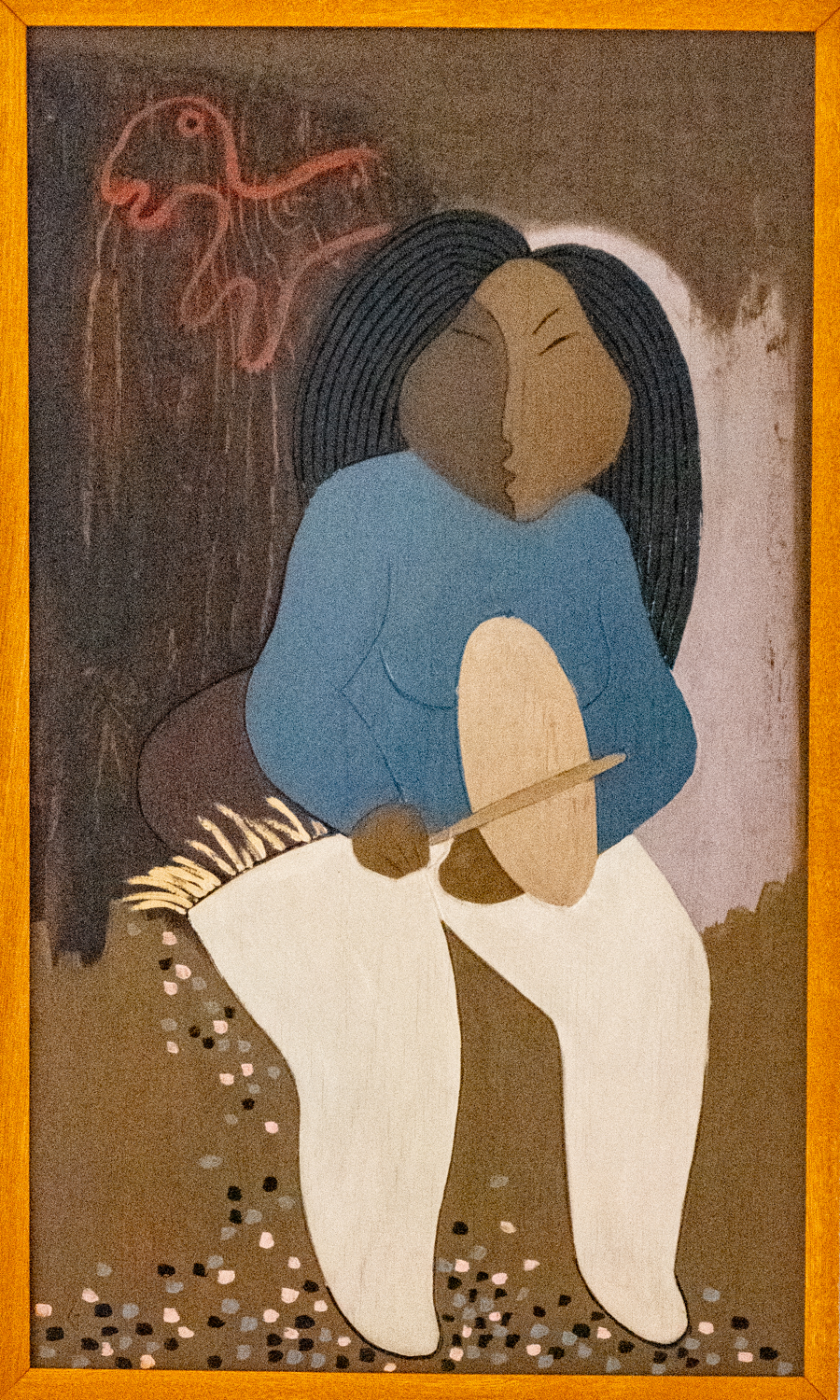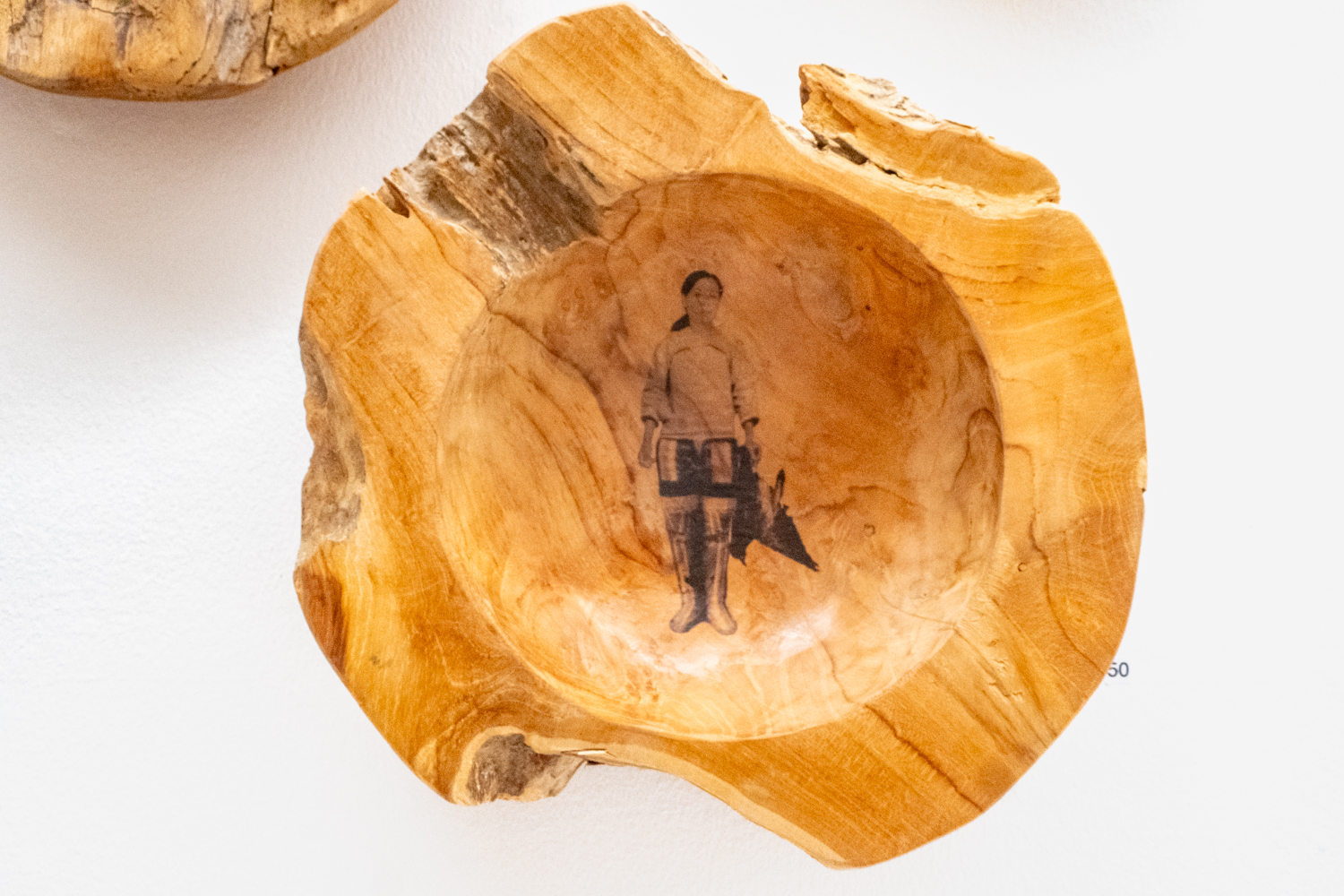
The Nuuk Art Museum is the only private arts and crafts museum in Greenland. The museum contains a notable collection of local paintings, watercolors, drawings, and graphics, some by Andy Warhol; and figures in soapstone, ivory, and wood, with many items collected by archaeologists. We learned that the Nuuk Art Museum had created an “art walk” through downtown Nuuk to “discover Nuuk through the art in the city” and had published, online, a booklet with a map and descriptions of the art works along the walk. Armed with the map and descriptions, the Intrepid Explorer and your blogger set out on an art exploratory tour of Greenland’s capital and discovered some beautiful and interesting works of art by Greenlandic and Nordic artists.
Kaassassuk is the name of a legend about an orphan by called Kaassassuk. He is humiliated and bullied in his settlement until he meets the Lord of Power (depicted in the photograph, above). In this sculpture Simon Kristoffersen shows Kaassassuk’s encounter with the Lord of Power. [See the photograph # 3, of the full sculpture, in our previous blog post, “Nuuk, Greenland (2023)” for Kaassassuk, on the right hand side.]. They look in separate directions. In the legend Kaassassuk is flung by the Lord of Power until he gets (almost) unconquerable powers. The artist has made the Lord of Power heavy, monumental and forceful, without a neck (pictured above), with dilated nostrils, big round eyes and no pupils and with legs ending suddenly like an elephant. After being flung by the Lord of Power, Kaassassuk is going out into the world, to learn how to use his powers. The sculpture was made in 1973 in the Royal Danish Academy of Art and was placed in front of the Rigshospitalet (a specialized hospital) in Copenhagen, until 1987, at which point it was moved to Nuuk.

A block away from the Nuuk Center and the Government of Greenland modern offices are the painted mosaic tiles of the ravens adorning the sides of apartment building towers, on Taupannguit (street). At the top of the apartment towers the ravens are flying from house to house. The many ravens playing over the rooftops belong to the winters in Nuuk, says the artist Rikke Diemer about the ravens on the apartment towers. Note that the ravens’ first flight was on the end of a block of apartments that were torn down and replaced by these towers in 2011. With these seven towers the ravens began flying again.

The sculpture called Inussuk by Niels Motzfeldt, 2009, stands on a hill overlooking the Colonial Harbor. The Greenlandic word Inussuk means cairn, or, directly translated, “something that looks like human beings.” A cairn directs us on our way in the mountains or on the fjord. The three columns are twisting and leaning against each other, united at the top. The columns symbolize the people of Greenland in the North, East, and West – joining and supporting each other. The sculpture is made of stone, copper, and concrete. The stones in the sculpture are from all over Greenland.

Right in front of Cafétuaq, in the Cultural Center Katuaq, there are four stones on the ground outside the building. On each of the four stones are engraved, colored marks (in different colors). They appear on the stones like ancient petroglyphs or carvings, like the secrets of cave paintings or as a prayer for the sun. Note that this is not an official decoration for the building. But they are there, as part of the Nuuk you have to go exploring and look for.

A group of three standing kayaks are located at the entrance to the Cultural Center Katuaq in the center of town. These are sculptures that one can sit in or play on – and a meeting point for some people to rest on. The sculptor, Isle Hessner, works with iron, trees and concrete in her sculptures. Materials she uses are often those used in the construction of buildings. Here the iron and concrete offer a windbreak – a shelter against snow and wind. At the same time, the snow and wind work with the iron kayaks, giving them their brownish patina.


Upstairs in the café Cafétuaq in the Cultural Center Katuaq in Nuuk, one gets the best view of the paintings by Aage Gitz-Johansen. Gitz-Johansen was called Qalipaasoruaq – the great painter. He was from Denmark but fell in love with Greenland and Sapmi cultures. He travelled to Greenland several times, and even lived there for short periods. He used the inspiration from mythologies and Greenlandic culture in his art. Gitz-Johansenv plays with lines, with the figures, and their relations on the ground of the canvas. The paintings are not telling anything specific about Greenland or Greenlandic culture. The painter was fascinated by the culture, by the human being, especially the female figure, and by the colors brown and blue – and he uses all of this as his motif.



The two paintings on the ends of the concrete apartment building are like street painting (one painting is shown in photograph # 10, above). The art phenomenon conquers and decorates public spaces of cities without asking for permission. This Street Art was supported by the municipality of Nuuk, but the initiative came from the artists themselves, Guido Van Helten and Stéfan Baldursson in 2014.
Legal Notices: All photographs copyright © 2023 by Richard C. Edwards. All Rights Reserved Worldwide. Permission to link to this blog post is granted for educational and non-commercial purposes only.

Your description (or maybe Wikipedia?)of each of these pieces gives them so much significance and deep meaning. Thanks.
Janis
LikeLiked by 1 person
Pingback: Nuuk Art Walk, Greenland | Tourism Sights Europe